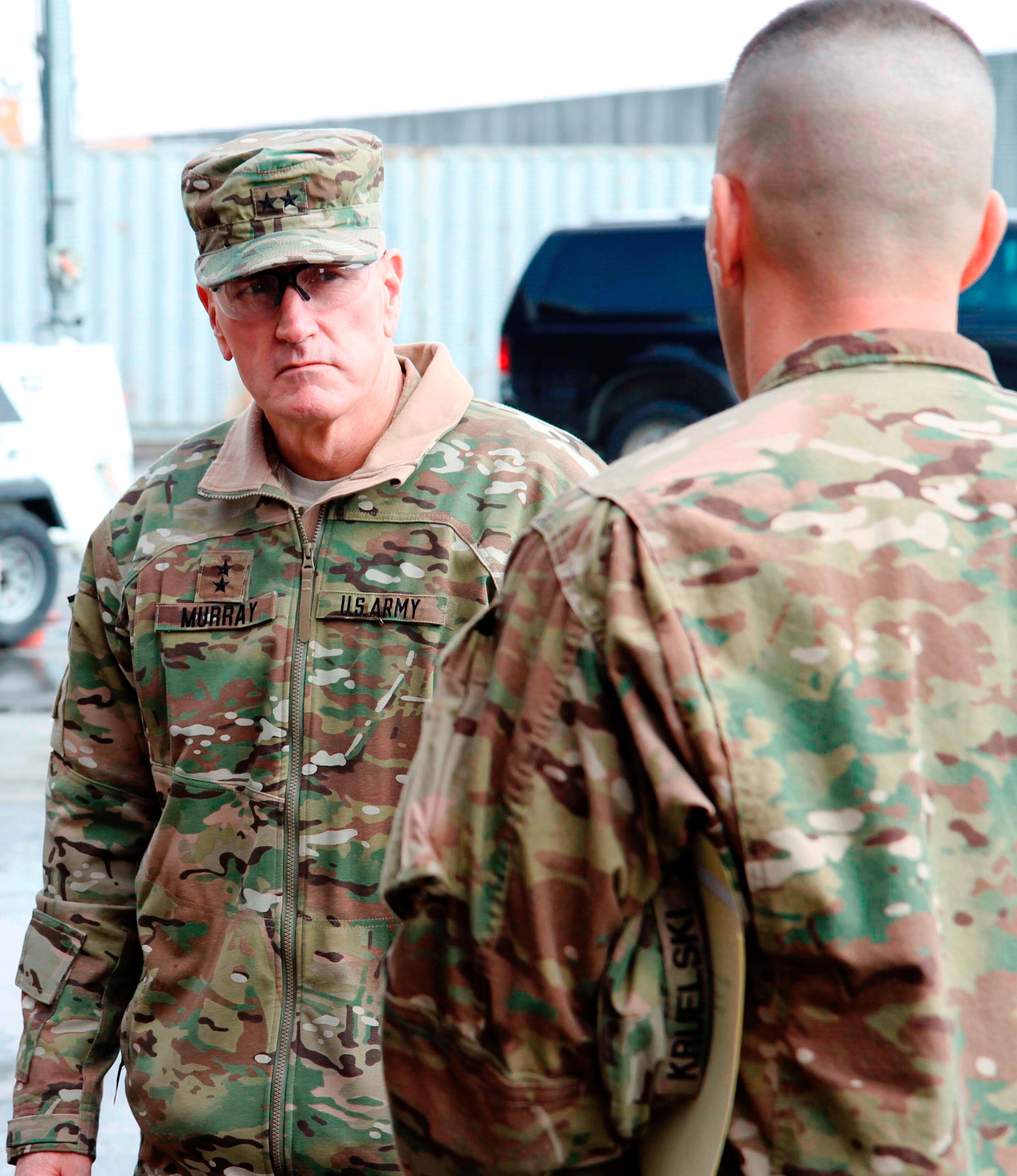Following President Obama's decision to slow the drawdown in Afghanistan, the focus of the troops has turned from retrograde and closing bases to the upcoming fighting season, a senior commander told Army Times.
Work still continues to draw down equipment and close outposts and bases across the country, but the speed of some of that work has slowed in line with the decision to keep about 10,000 U.S. troops in theater into 2016, Murray said.

Maj. Gen. Mike Murray expects the Taliban to focus more on Afghan security forces this fighting season and less on international forces.
Photo Credit: Sgt. 1st Class Chris Bridson/Army
Before Obama's March 24 announcement, plans called for the U.S. presence to shrink to about 5,000 by the end of this year. The White House announcement came after months of internal administration debate over the timeline Obama laid out last May. The rise of Islamic State militants in Iraq also fueled concerns that the initial plan was pulling out U.S. forces too quickly.
The decision was made "in part because we want to make sure we are doing everything we can to help the Afghan security forces succeed, so we don't have to go back, so we don't have to respond in an emergency because terrorist activities are being launched out of Afghanistan," Obama said at the time. "It made sense for us to provide a few extra months for us to be able to help in things like logistics ... training, advising and strategic input."
The slowing of the drawdown allows troops assigned to the Resolute Support mission, under the command of Gen. John Campbell, to focus on advising and assisting the Afghan National Security Forces as they gear up for the spring and summer fighting season, Murray said.
"This is a very important fighting season for this country because of where they are with their improved relationship with Pakistan, where they are in terms of a small sliver of hope in terms of talks with the Taliban, where they are with a young government," Murray said.
The Taliban is already making its move. On April 9, the Taliban attacked an Afghan court facility in Mazar-I-Sharif, leaving several dead and injured. The attack, which was condemned by Headquarters Resolute Support, killed or wounded police, prosecutors, court staff, women and children, the coalition said in a statement.
Any further decisions about which bases to close and how much equipment to send home likely won't be made until after the fighting season, he said.
"We're still very much in the planning process in terms of what that looks like," he said. "There probably will be no movement on that until fall, after we see what the fighting season looks like."
During his interview April 8 with Army Times, Murray discussed several issues and provided an update on what's taking place on the ground. Here's what he had to say.
State of the ANSF
The Afghan National Security Forces have been leading the fight across the country, Murray said. During recent operations in north Helmand, the Afghans conducted their own close-air support and medical evacuation missions, he said.
"That was, by all accounts, a very successful operation on the part of the Afghans, primarily because it gives them some momentum going into fighting season '15," Murray said.
Three Afghan National Army corps participated in the operation, alongside the Afghan police, he said. The Afghan government also played "a key role" in planning for how the troops would hold the ground they've cleared over the past two months, Murray said.
"We helped them in the planning process and intel build, but it was almost solely an Afghan operation with very, very minimal help from coalition forces," he said. "They've got two or three more operations like that planned for the fighting season. Long-term, we'll see how well they can hold the ground they've cleared."
State of the Taliban
It's likely the Taliban will try for some high-profile attacks this fighting season, Murray said.
"It's about maintaining relevancy," he said.
Murray also predicts the enemy will focus more on targeting Afghan troops than international forces.
"They're going to challenge the Afghan security forces more than they're going to try to challenge coalition forces," Murray said. "I think the Taliban are probably going to try to take some district centers again and take some territory, but I really don't think the Taliban are an existential threat to the country of Afghanistan. The ANSF will come out of this fighting season with momentum, with the territory intact here in Afghanistan."
Help provided
For the most part, the Afghans are conducting operations on their own, Murray said.
"Will there be cases where they'll come to us for some [intelligence, surveillance and reconnaissance] or CAS? I'm sure there will be. But they're going to have to prove to us that they've expended all their capability, I think, before the boss will entertain that."
The Taliban doesn't have Howitzers, close-air support assets or helicopters capable of air-ground engagements, while the Afghan forces do, Murray said. What the coalition is trying to do is strike a balance, he said.
"It's tough love, teaching them how to use the enablers they've got but not letting them lose," Murray said.
The Resolute Support mission headquarters has a "very deliberate" process for what assistance it will provide and when, he said.
"They've got the capability. They've just got to figure it out, not only this year, but also the next number of years," he said. "They've got to figure how to integrate and use that capability and get it where it needs to be at the right time."
Islamic State fighters in Afghanistan
"They're here, there is some recruiting going on," Murray said.
Campbell has described their presence as "nascent, which I agree with," Murray said.
"Most of it is really changing a white [Taliban] flag for a black [Islamic State] flag," he said.
Some insurgents who may be swayed to change their "allegiance" may be dissatisfied with senior Taliban leaders, or the "lack of any visible signs of life from Mullah Omar," the group's leader, or simply because the Islamic State group is paying more than the Taliban, he said.
The dynamics in Afghanistan also are different from those in Iraq, where the Islamic State group quickly took hold.
"Daesh took off in Iraq, Syria primarily because of the sectarian split and the friction between Sunni and Shia," Murray said. "You really don't have that environment here. The environment here really is not conducive here for Daesh to take off like it did in Syria and Iraq. And the Taliban has always been adamant that you're welcome to fight your jihad here, but you fight under the Taliban flag."
Despite these differences, U.S. and coalition leaders are paying close attention to Daesh and its movements in Afghanistan, Murray said.
"Are we keeping an exceptionally close eye on it? Absolutely," he said.
Impact of the draw down on soldier deployments
Murray, who is in charge of force management for U.S. Forces-Afghanistan, said he does not anticipate disruptions or extended tours for soldiers in light of the slowed drawdown.
"If a soldier was scheduled to be here for nine months, he'll be here for nine months," he said. "If a soldier was scheduled to be here for 12 months, he'll be here for 12 months."
The Army has, through Forces Command, identified forces to deploy to support Resolute Support through 2016, Murray said.
"There are no 15-month deployments coming for anybody," he said. "The Army's been very deliberate about not extending people. We've been sticking to that."
Update on the retrograde
In the last 12 months, U.S. Forces-Afghanistan has reduced its installations by nearly 83 percent, going from about 90 to about 15. At the height of the surge in Afghanistan a few years ago, there were more than 800 bases and outposts across the country. Today, only a few key ones remain, including Bagram Air Field, Kandahar Air Field, the cluster of bases in Kabul, Tactical Base Gamberi, Camp Dwyer and Forward Operating Base Fenty.
In the past 12 months, the military also has reduced its vehicles in theater by about 70 percent — from 17,000 vehicles to about 5,000. Military equipment dropped by about 80 percent during that same one-year period. That's equivalent to about 2,400 shipping containers worth of equipment that was sent home, destroyed or turned over to the Afghans.
Murray and his staff continue to plan for even further drawdown, with plans stretching out to the middle of 2016 to help ease the burden on the unit that comes in after them.
"The less they've got to worry about in '16, the better off it's going to be," he said.
The withdrawal timeline in 2016 "is going to be compressed," Murray said.
"It's all doable, but it's going to be interesting," he said.
Staff writer Andrew Tilghman contributed to this report.
Michelle Tan is the editor of Army Times and Air Force Times. She has covered the military for Military Times since 2005, and has embedded with U.S. troops in Iraq, Afghanistan, Kuwait, Haiti, Gabon and the Horn of Africa.





